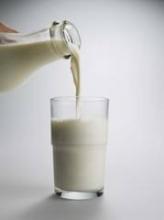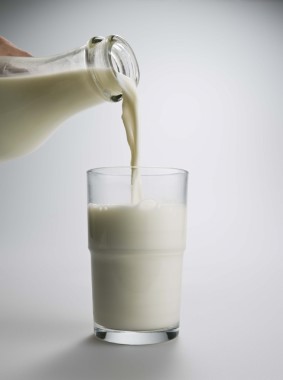User login
SAN DIEGO– Omalizumab appears to significantly reduce adverse effects from oral immunotherapy for cows’ milk allergy, allowing patients to reach maintenance doses of powdered skim milk sooner, according to the first double-blind, randomized, placebo-controlled trial to see if omalizumab makes oral immunotherapy safer.
The investigators randomized 28 milk-allergic subjects to omalizumab (Xolair) injections during oral immunotherapy (OIT) and 29 others to dummy shots for 16 months. The median age in the trial was about 10 years; 70% of the subjects were male; and most had asthma, allergic rhinitis, and other food allergies.
Milk OIT was started after 4 months, with the goal of escalating patients to a maintenance dose of 3.84 g/day of powdered skim milk.
Just one omalizumab patient needed an epinephrine shot, while nine placebo subjects needed a total of 17 epinephrine shots. Omalizumab subjects had a median of five OIT symptoms – for instance, perioral itching, tingling, or hives; mild throat symptoms; and abdominal cramps – during escalation and maintenance therapy, while the placebo group had a median of 47.5 (P =.0001).
Omalizumab subjects needed a median of 198 OIT doses to reach maintenance dosing in a median of 25.9 weeks; placebo patients needed a median of 224.5 doses to reach maintenance in a median of 30.8 weeks. The differences were significant.
"OIT is very promising" as a way to desensitize patients, but "it’s still very experimental. The major limitation is the frequency of side effects. The reactions are unpredictable and [mostly] occur at home, so there’s a real risk to this therapy. We don’t really have a good idea of who is not going to do well until they actually develop the reactions. There’s a risk that some of these kids might develop other allergic problems like eosinophilic esophagitis, or you could make them more sensitive," said lead investigator Dr. Jennifer S. Kim, a pediatric allergist and immunologist at the North Shore University Health System in Chicago.
"To make OIT safer, omalizumab is being studied. When our results were unblinded, I was happy to see that it works," she said at the annual meeting of the American Academy of Allergy, Asthma, and Immunology.
There were no statistically significant baseline differences between the two study arms for age or baseline milk specific IgE (median 39.4 kUA/L omalizumab vs. 42.0 kUA/L control), milk PST wheal (median 10.0 mm omalizumab vs. 8.0 mm control), or food challenge doses at first symptoms (20 mg in both groups).
Omalizumab is a subcutaneous injection currently indicated only for allergic asthma. It was dosed according to product labelling – every 2-4 weeks depending on weight and IgE levels. "We did not really have any adverse effects from the injection," Dr. Kim said.
Powdered milk was used for OIT because it’s easier to dispense to subjects and less likely to spoil than fresh milk, among other reasons. Patients dissolved it in whatever they chose, often Gatorade. "It wasn’t peoples’ favorite thing to take on a daily basis," she said.
The results are from an interim analysis, and the study is ongoing.
The National Institutes of Health funded the project. The omalizumab used in the trial was donated by its maker, Genentech, and comarketer, Novartis. Dr. Kim said that she has no disclosures. The senior author, Dr. Hugh Sampson of Mount Sinai Hospital in New York, is an unpaid advisor to Novartis.
SAN DIEGO– Omalizumab appears to significantly reduce adverse effects from oral immunotherapy for cows’ milk allergy, allowing patients to reach maintenance doses of powdered skim milk sooner, according to the first double-blind, randomized, placebo-controlled trial to see if omalizumab makes oral immunotherapy safer.
The investigators randomized 28 milk-allergic subjects to omalizumab (Xolair) injections during oral immunotherapy (OIT) and 29 others to dummy shots for 16 months. The median age in the trial was about 10 years; 70% of the subjects were male; and most had asthma, allergic rhinitis, and other food allergies.
Milk OIT was started after 4 months, with the goal of escalating patients to a maintenance dose of 3.84 g/day of powdered skim milk.
Just one omalizumab patient needed an epinephrine shot, while nine placebo subjects needed a total of 17 epinephrine shots. Omalizumab subjects had a median of five OIT symptoms – for instance, perioral itching, tingling, or hives; mild throat symptoms; and abdominal cramps – during escalation and maintenance therapy, while the placebo group had a median of 47.5 (P =.0001).
Omalizumab subjects needed a median of 198 OIT doses to reach maintenance dosing in a median of 25.9 weeks; placebo patients needed a median of 224.5 doses to reach maintenance in a median of 30.8 weeks. The differences were significant.
"OIT is very promising" as a way to desensitize patients, but "it’s still very experimental. The major limitation is the frequency of side effects. The reactions are unpredictable and [mostly] occur at home, so there’s a real risk to this therapy. We don’t really have a good idea of who is not going to do well until they actually develop the reactions. There’s a risk that some of these kids might develop other allergic problems like eosinophilic esophagitis, or you could make them more sensitive," said lead investigator Dr. Jennifer S. Kim, a pediatric allergist and immunologist at the North Shore University Health System in Chicago.
"To make OIT safer, omalizumab is being studied. When our results were unblinded, I was happy to see that it works," she said at the annual meeting of the American Academy of Allergy, Asthma, and Immunology.
There were no statistically significant baseline differences between the two study arms for age or baseline milk specific IgE (median 39.4 kUA/L omalizumab vs. 42.0 kUA/L control), milk PST wheal (median 10.0 mm omalizumab vs. 8.0 mm control), or food challenge doses at first symptoms (20 mg in both groups).
Omalizumab is a subcutaneous injection currently indicated only for allergic asthma. It was dosed according to product labelling – every 2-4 weeks depending on weight and IgE levels. "We did not really have any adverse effects from the injection," Dr. Kim said.
Powdered milk was used for OIT because it’s easier to dispense to subjects and less likely to spoil than fresh milk, among other reasons. Patients dissolved it in whatever they chose, often Gatorade. "It wasn’t peoples’ favorite thing to take on a daily basis," she said.
The results are from an interim analysis, and the study is ongoing.
The National Institutes of Health funded the project. The omalizumab used in the trial was donated by its maker, Genentech, and comarketer, Novartis. Dr. Kim said that she has no disclosures. The senior author, Dr. Hugh Sampson of Mount Sinai Hospital in New York, is an unpaid advisor to Novartis.
SAN DIEGO– Omalizumab appears to significantly reduce adverse effects from oral immunotherapy for cows’ milk allergy, allowing patients to reach maintenance doses of powdered skim milk sooner, according to the first double-blind, randomized, placebo-controlled trial to see if omalizumab makes oral immunotherapy safer.
The investigators randomized 28 milk-allergic subjects to omalizumab (Xolair) injections during oral immunotherapy (OIT) and 29 others to dummy shots for 16 months. The median age in the trial was about 10 years; 70% of the subjects were male; and most had asthma, allergic rhinitis, and other food allergies.
Milk OIT was started after 4 months, with the goal of escalating patients to a maintenance dose of 3.84 g/day of powdered skim milk.
Just one omalizumab patient needed an epinephrine shot, while nine placebo subjects needed a total of 17 epinephrine shots. Omalizumab subjects had a median of five OIT symptoms – for instance, perioral itching, tingling, or hives; mild throat symptoms; and abdominal cramps – during escalation and maintenance therapy, while the placebo group had a median of 47.5 (P =.0001).
Omalizumab subjects needed a median of 198 OIT doses to reach maintenance dosing in a median of 25.9 weeks; placebo patients needed a median of 224.5 doses to reach maintenance in a median of 30.8 weeks. The differences were significant.
"OIT is very promising" as a way to desensitize patients, but "it’s still very experimental. The major limitation is the frequency of side effects. The reactions are unpredictable and [mostly] occur at home, so there’s a real risk to this therapy. We don’t really have a good idea of who is not going to do well until they actually develop the reactions. There’s a risk that some of these kids might develop other allergic problems like eosinophilic esophagitis, or you could make them more sensitive," said lead investigator Dr. Jennifer S. Kim, a pediatric allergist and immunologist at the North Shore University Health System in Chicago.
"To make OIT safer, omalizumab is being studied. When our results were unblinded, I was happy to see that it works," she said at the annual meeting of the American Academy of Allergy, Asthma, and Immunology.
There were no statistically significant baseline differences between the two study arms for age or baseline milk specific IgE (median 39.4 kUA/L omalizumab vs. 42.0 kUA/L control), milk PST wheal (median 10.0 mm omalizumab vs. 8.0 mm control), or food challenge doses at first symptoms (20 mg in both groups).
Omalizumab is a subcutaneous injection currently indicated only for allergic asthma. It was dosed according to product labelling – every 2-4 weeks depending on weight and IgE levels. "We did not really have any adverse effects from the injection," Dr. Kim said.
Powdered milk was used for OIT because it’s easier to dispense to subjects and less likely to spoil than fresh milk, among other reasons. Patients dissolved it in whatever they chose, often Gatorade. "It wasn’t peoples’ favorite thing to take on a daily basis," she said.
The results are from an interim analysis, and the study is ongoing.
The National Institutes of Health funded the project. The omalizumab used in the trial was donated by its maker, Genentech, and comarketer, Novartis. Dr. Kim said that she has no disclosures. The senior author, Dr. Hugh Sampson of Mount Sinai Hospital in New York, is an unpaid advisor to Novartis.
AT THE 2014 AAAAI ANNUAL MEETING
Major finding: During escalation and maintenance cows’ milk OIT, just 1 of 28 patients on adjunctive omalizumab needed epinephrine rescue, versus 9 of 29 subjects on adjunctive placebo.
Data Source: Randomized, double-blind, placebo-controlled trial in 57 patients, mostly children, undergoing OIT for cows’ milk allergy.
Disclosures: The National Institutes of Health funded the project. The omalizumab used in the trial was donated by its maker, Genentech, and comarketer, Novartis. Dr. Kim said that she has no disclosures.


